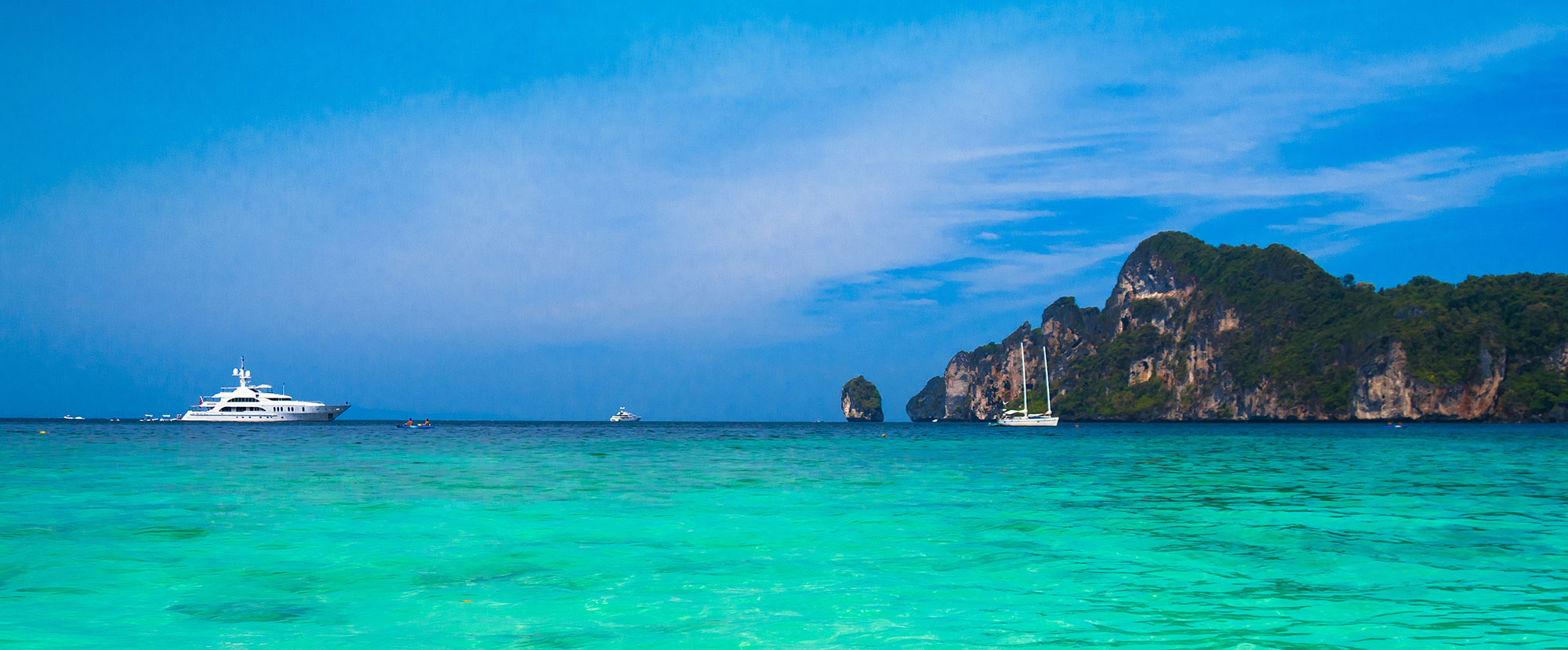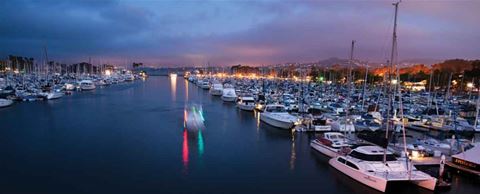
News Details
Navigating at Night Posted on September 08, 2015

Darkness creeps across the water as the glow of the sun fades below the western horizon. It is night. For some, it’s a time of high anxiety when running a boat. Humans are visual. When the lights go out, we get nervous. Rightfully so, for who knows what might go bump in the night?
Yet, nighttime navigators need not bite their nails. With the right equipment and decent weather, a night cruise can be safe, enjoyable, adventurous and even romantic.
Fortunately, there are more tools than ever to enhance or supplant our vision when navigating at night. GPS/chart plotters, detailed electronic cartography, advanced radar, thermal imaging, night-vision scopes and spotlights not only increase the safety factor but also inspire enough confidence to enjoy boating after dark.
Slow and Easy
The first rule of night boating is to slow down, no matter what high-tech navigation equipment you have on board. Even on a moonlit evening, you just can’t see as well as during the day. Objects won’t come into view until they are fairly close. If you’re going too fast, you might not be able to maneuver quickly enough to avoid a collision with an unlit object such as a crab-pot buoy or floating timber.
The best speed on any given night depends on visibility. During a full moon, you might feel comfortable running the boat a bit faster than you would on a night when everything fades to black. Are you in open isolated water, or are you bound by the confines of a narrow channel? The locale plays into how fast is safe as well. The important thing is not to rush. Just like on a romantic date, take it easy, cowboy.
Mood Lighting
Onboard lighting is a tricky thing when navigating at night. You need backlighting to see your instruments and electronics, and an overhead light to read a chart.
Yet once your eyes have acclimated to the dark, too much onboard light can destroy your night vision. Once this occurs, your eyes will need to readjust: Your pupils need to rewiden, and the rods, special cells that provide most of what we call “night vision,” must resensitize. This can take as long as 35 to 40 minutes.
With this in mind, most marine electronics allow you to adjust the brightness of the backlighting, and many units also have a “night mode” with a darker background to keep illumination levels to a minimum.
When it comes to instrument illumination, red is the best color since it doesn’t desensitize the rods. Most newer instruments are equipped with dimmers to adjust the intensity of backlighting and preserve night vision. If yours isn’t, a dimmer switch can be wired in for control. One of the latest is the DeckHand Dimmer from Blue Sea Systems ($99.98, bluesea.com). Most dimmers handle only one type of lighting, such as incandescent, halogen or LED. However, the DeckHand Dimmer can handle any or all of these lights at the same time.
Overhead and chart lights from companies such as Hella (hellamarine.com) are also available in red — including low-draw LED versions — should you need to read something at the helm.
When navigating at night, avoid turning on flashlights, spreaders or other bright lights that can destroy night vision. As on a romantic date, you want to keep the lighting dim.
Wherefore Art Thou?
Should your date paraphrase the classic Shakespearean question “Wherefore art thou, captain?” you should be able to point to your GPS/chart plotter and answer “right here.”
Thanks to detailed electronic cartography from C-Map (c-map.com), Navionics (navionics.com) and others, today’s chart plotters show a lot more than just your present position. Virtually any fixed object above water, such as buoys, jetties, exposed rocks and docks, show up on the plotter, just as it would on a paper chart, while at the same time showing the boat’s relative position to these objects. Chart plotters also indicate water depth, reefs and other submerged obstructions, so you can avoid running aground at night. A few chart plotters can also do some of the thinking
for you.
For example, with the Guardian alarm on C-Map-enabled plotters from Si-Tex (si-tex.com), Standard Horizon (standardhorizon.com) and earlier models from Furuno (furunousa.com), you can set a guard zone, much as you would with radar, that scans the chart area ahead and alerts you if your course is projected to put the boat upon shoals, rocks, sand spits or other threats.
“You set a minimum draft such as six feet and set a look-ahead distance such as a quarter-mile,” says C-Map’s Ken Cirillo. “Then the plotter looks at all possible obstructions, as well as shoals, in a searchlight pattern and alerts you to danger.”
Of course, a depth sounder is also important for confirming the water depth. Whether cruising at night or during the day, you should not rely solely on the electronic chart, particularly if the chart has not been updated recently. As to that, C-Map and Navionics both offer updating services, for a fee, and you can get updates from the U.S. Coast Guard’s Local Notices to Mariners at navcen.uscg.gov.
Radar Love
Seeing everything that’s around you at night makes you feel more confident while cruising, and that’s just what radar (radio detection and ranging) is: your sight when your eyes are blind.It shows you what’s out there and tells you how far away it is. Ask a group of experienced boaters what they rely on most at night — besides their own eyes — and most will say radar.
While a chart plotter shows fixed objects, radar can show you just about everything above the water’s surface, including other boats. Marine radar has been around for decades, but today’s radar systems are more refined, easier to use and less power hungry than ever before.
Traditionally, radar loses effectiveness at very close range due to a phenomenon called “main bang,” which results in a blob in the middle of the screen that obscures targets close to the boat.
However, newer radars such as the Lowrance and Simrad Broadband units (navico.com) don’t have the main bang, so they can read an object very close to the boat. While such units are not very effective at ranges beyond a few miles (the new Simrad Broadband 3G radar has greater range), the close-in target detection feature can be useful when cruising crowded waters in the dark.
Most multifunction displays, such as the Furuno NavNet system, can also be configured to “overlay” the radar readings on an electronic chart display. This provides an enhanced view of the surroundings at night and also allows you to more readily interpret the radar images, relating them immediately to objects on the chart.
Plus, you know any radar target that is not on the chart is most likely another boat or barge, though it could also be an off-station buoy.
You can also set the radar guard zone, but in crowded waters with lots of fixed objects, the guard zone alarm tends to sound too frequently. This feature is most helpful when cruising open water far from the clutter of the harbor.
Light Up the Night
Boats don’t have brakes. Know what? They don’t have headlights either. And with good reason. In open water, the light reflecting off waves and mist is often more blinding than beneficial at night. Try shining a light ahead of the boat at night while under way when there is nothing but water and sky to see, and you’ll agree.
However, there are occasions when a searchlight or spotlight is handy, particularly if you are trying to locate or identify a nearby object such as an unlit boat, buoy, shoreline or jetty.
There are three basic types of spotlights — fixed-mount, remote-control searchlights such as the Jabsco 135SL (jabscoshop.com, $187.99); handhelds with 12-volt plugs such as the Optronics NightBlaster BlueEye 400,000 Candlepower (optronicsinc.com, $36.99); and rechargeable battery-operated handhelds such as the Brinkmann Q-Beam LED (brinkmann.net, $69.99).
Fixed-mounts are nice on bigger boats, while handhelds lend themselves to smaller boats. Whichever you choose, try to use the light sparingly and briefly, particularly if there are other boaters in the immediate vicinity. The harsh glare of a spotlight is not only annoying to others, but it also can ruin the night vision of nearby skippers. And nothing sours an intimate cruise quicker than another boater who is hopping mad at you.
Docking lights are another option, usually flush-mounted just below the rub rail on both sides of the bow. Yet, they are designed for use only in close-quarters situations such as when pulling into a slip at night. They don’t cast their beam far enough to be of as much use as the auto headlights they resemble.
Scope Things Out
You can also buy night vision — a technology that amplifies light through a scope. This lets you see as if it were daytime, though everything’s cast in green. For tricky harbor entrances or foreboding shorelines, night vision is tough to beat.
An affordable night-vision device is the NVD mini scope from Minox (minox.com, $299). Measuring just 5½ inches long and 2 inches in diameter, this rechargeable scope not only amplifies available light, but also beams infrared light. Though invisible to the human eye, the reflected infrared light is picked up by the scope and illuminates objects up to 200 feet away.
Learn the Lights
The U.S. Coast Guard has long-established light display standards for nighttime navigation, and these apply to both vessels and navaids such as channel markers. If you know the navigation light patterns, you can identify any type of vessel and its activity, as well as determine where to safely enter and exit a harbor at night.
If you do much night boating, knowing the meaning of lights is essential and might save your boat and your life. For example, you see two vessels in the distance and they’re a few hundred yards apart. So to save time, you think about cutting between the two. However, if one of the vessels is displaying three-stacked white lights on the masthead, going between them could be fatal, because the vessel is a tug towing a barge (the second vessel) with a massive hawser. Cut between them, and at best the hawser will rip out your running gear; at worst it will saw across your deck and everything on it.
Eyes and Ears
In the end, the most valuable navigation tool is a sharp eye. And the more, the better when darkness falls. There should be two pairs of eyes (and ears, since sound travels well on the water) on the bridge at night. Modern navigation gear’s great, but nothing beats a good lookout.
There are a number of things that can interfere with maintaining a lookout, not the least of which is nav gear itself. For example, if you have your head down fiddling with a chart plotter or radar, you have taken your eyes off the road, so to speak — not a good practice while under way. That’s why having a second lookout is important.
Also, with two lookouts, it is less likely that either will fall asleep on the bridge. This is a real issue, particularly on long night passages while using autopilot and sitting in a comfortable helm chair. It is just too easy to drift off, and that’s why a commercial vessel must have a “watch alarm” that the skipper must press to turn off at set intervals.
Having that someone special on the bridge at night might keep you from falling asleep, but it can distract from maintaining a lookout. So if you decide to embrace the evening aboard your boat, make sure your date knows that, while you’re under way, you need to keep your hands on the wheel and throttle, and you only have eyes for the water ahead.
Source: http://www.boatingmag.com/boatingsafety/navigating-night